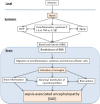Immunosenescence in neurocritical care
- PMID: 30349725
- PMCID: PMC6186132
- DOI: 10.1186/s40560-018-0333-5
Immunosenescence in neurocritical care
Abstract
Background: Several advanced and developing countries are now entering a superaged society, in which the percentage of elderly people exceeds 20% of the total population. In such an aging society, the number of age-related diseases such as malignant tumors, diabetes, and severe infections including sepsis is increasing, and patients with such disorders often find themselves in the ICU.
Main body: Age-related diseases are closely related to age-induced immune dysfunction, by which reductions in the efficiency and specificity of the immune system are collectively termed "immunosenescence." The most noticeable is a decline in the antigen-specific acquired immune response. The exhaustion of T cells in elderly sepsis is related to an increase in nosocomial infections after septicemia, and even death over subacute periods. Another characteristic is that senescent cells that accumulate in body tissues over time cause chronic inflammation through the secretion of proinflammatory cytokines, termed senescence-associated secretory phenotype. Chronic inflammation associated with aging has been called "inflammaging," and similar age-related diseases are becoming an urgent social problem.
Conclusion: In neuro ICUs, several neuro-related diseases including stroke and sepsis-associated encephalopathy are related to immunosenescence and neuroinflammation in the elderly. Several advanced countries with superaged societies face the new challenge of improving the long-term prognosis of neurocritical patients.
Keywords: Elderly; Immune paralysis; Immunosenescence; Sepsis.
Conflict of interest statement
Not applicable.Not applicable.The authors declare that they have no competing interests.Springer Nature remains neutral with regard to jurisdictional claims in published maps and institutional affiliations.
Figures





Similar articles
-
Immunosenescence: molecular mechanisms and diseases.Signal Transduct Target Ther. 2023 May 13;8(1):200. doi: 10.1038/s41392-023-01451-2. Signal Transduct Target Ther. 2023. PMID: 37179335 Free PMC article. Review.
-
The Role of Immunosenescence in the Development of Age-Related Diseases.Rev Invest Clin. 2016 Mar-Apr;68(2):84-91. Rev Invest Clin. 2016. PMID: 27103044 Review.
-
Immunosenescence, Inflammaging, and Lung Senescence in Asthma in the Elderly.Biomolecules. 2022 Oct 11;12(10):1456. doi: 10.3390/biom12101456. Biomolecules. 2022. PMID: 36291665 Free PMC article. Review.
-
The diseased kidney: aging and senescent immunology.Immun Ageing. 2022 Nov 16;19(1):58. doi: 10.1186/s12979-022-00313-9. Immun Ageing. 2022. PMID: 36384564 Free PMC article. Review.
-
Vaccination in the elderly: The challenge of immune changes with aging.Semin Immunol. 2018 Dec;40:83-94. doi: 10.1016/j.smim.2018.10.010. Semin Immunol. 2018. PMID: 30501873 Review.
Cited by
-
Gut dysbiosis and age-related neurological diseases; an innovative approach for therapeutic interventions.Transl Res. 2020 Dec;226:39-56. doi: 10.1016/j.trsl.2020.07.012. Epub 2020 Aug 2. Transl Res. 2020. PMID: 32755639 Free PMC article. Review.
-
Protective effects of S100A8 on sepsis mortality: Links to sepsis risk in obesity and diabetes.iScience. 2022 Nov 23;25(12):105662. doi: 10.1016/j.isci.2022.105662. eCollection 2022 Dec 22. iScience. 2022. PMID: 36505926 Free PMC article.
-
Prolonged Reactive Oxygen Species Production following Septic Insult.Immunohorizons. 2021 Jun 18;5(6):477-488. doi: 10.4049/immunohorizons.2100027. Immunohorizons. 2021. PMID: 34145054 Free PMC article.
-
Age and Sex Influence the Hippocampal Response and Recovery Following Sepsis.Mol Neurobiol. 2019 Dec;56(12):8557-8572. doi: 10.1007/s12035-019-01681-y. Epub 2019 Jul 5. Mol Neurobiol. 2019. PMID: 31278440 Free PMC article.
-
Biological Age, Aging Clocks, and the Interplay with Lymphoid Neoplasms: Mechanisms and Clinical Frontiers.Lymphatics. 2025 Sep;3(3):19. doi: 10.3390/lymphatics3030019. Epub 2025 Jul 11. Lymphatics. 2025. PMID: 40726806 Free PMC article.
References
Publication types
LinkOut - more resources
Full Text Sources

